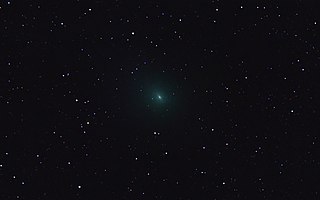Related Research Articles
Comet 87P/Bus is a periodic comet with an orbital period of 6.5 years. It fits the definition of an Encke-type comet with. It was discovered by Schelte J. Bus in 1981 on a plate taken with the 1.2m UK Schmidt telescope at Siding Spring, Australia. The discovery was announced in IAU Circular 3578 on March 4, 1981.

10P/Tempel, also known as Tempel 2, is a periodic Jupiter-family comet with a 5 year orbital period. It was discovered on July 4, 1873 by Wilhelm Tempel. The next perihelion passage is 2 August 2026 when the comet will have a solar elongation of 164 degrees at approximately apparent magnitude 8. Closest approach to Earth will be one day later on 3 August 2026 at a distance of 0.414 AU (61.9 million km).

49P/Arend–Rigaux is a periodic comet in the Solar System.

60P/Tsuchinshan, also known as Tsuchinshan 2, is a periodic comet in the Solar System with an orbital period of 6.79 years. Tsuchinshan is the Wade-Giles transliteration corresponding to the pinyin Zĭjīn Shān, which is Mandarin Chinese for "Purple Mountain".

78P/Gehrels, also known as Gehrels 2, is a Jupiter-family periodic comet in the Solar System with a current orbital period of 7.22 years.

84P/Giclas is a periodic comet in the Solar System. The comet nucleus is estimated to be 1.8 kilometers in diameter. In 1995 precovery images from three nights in September 1931 by Clyde W. Tombaugh were located.
98P/Takamizawa is a periodic comet in the Solar System.
102P/Shoemaker, also known as Shoemaker 1, is a periodic comet in the Solar System. It was first seen in 1984 and then again in 1991. Images taken of it in 1999 were not recognized until 2006 when it was once again observed. It was unexpectedly dim in each of these returns.
111P/Helin–Roman–Crockett is a periodic comet in the Solar System. It was discovered by Eleanor and Ron Helin on 5 January 1989 from images obtained on the 3rd and 4th of that month. It is a Jupiter family comet known for extremely close approaches to Jupiter being a Quasi-Hilda comet. During these approaches, it actually orbits Jupiter. The last such approach was in 1976, the next will be in 2071. The Jovian orbits are highly elliptical and subject to intense Solar perturbation at apojove which eventually pulls the comet out of Jovian orbit for the cycle to begin anew.

157P/Tritton is a periodic comet with a 6-year orbital period. Fragment B was first observed on 21 August 2022.
158P/Kowal–LINEAR is a periodic comet in the Solar System that has an orbit out by Jupiter.
165P/LINEAR is a periodic comet in the Solar System. 165P/LINEAR has a perihelion distance of 6.8 AU, and is a Chiron-type comet with.
178P/Hug–Bell is a periodic comet in the Solar System. It was discovered by Northeast Kansas Amateur Astronomers' League members Gary Hug and Graham Bell and is thought to be the first periodic comet to be discovered by amateurs. It was declared a comet less than two days after its initial discovery, after having its course confirmed on previous images.
Comet Crommelin, also known as Comet Pons-Coggia-Winnecke-Forbes, is a periodic comet with an orbital period of almost 28 years. It fits the classical definition of a Halley-type comet with. It is named after the British astronomer Andrew C. D. Crommelin who calculated its orbit in 1930. It is one of only four comets not named after their discoverer(s), the other three being Comets Halley, Encke, and Lexell. It next comes to perihelion around May 27, 2039 when it will be near a maximum near-perihelion distance from Earth.

45P/Honda–Mrkos–Pajdušáková is a short-period comet discovered by Minoru Honda December 3, 1948. It is named after Minoru Honda, Antonín Mrkos, and Ľudmila Pajdušáková. The object revolves around the Sun on an elliptical orbit with a period of 5.25 years. The nucleus is 1.3 kilometers in diameter. On August 19 and 20, 2011, it became the fifteenth comet detected by ground radar telescope.

94P/Russell 4 is a periodic comet in the Solar System. It fits the definition of an Encke-type comet with. It was discovered by Ken Rusell on photographic plates taken by M. Hawkins on March 7, 1984. In the discovery images, Russell estimated that the comet had an apparent magnitude of 13 and a noticeable tail of 5 arc minutes. In the year of discovery, the comet had come to perihelion in January 1984.
255P/Levy, formerly P/2006 T1 and P/2011 Y1, is a periodic comet with an orbital period of 5.25 years. It last came to perihelion on 14 January 2012. During the 2006 passage the comet achieved an apparent magnitude of ~9.5. Levy (PK06T010) was believed to have been recovered on 3 June 2011 at magnitude 19.8, but other observatories were unable to confirm a recovery. It was most likely a false positive because of large residuals. Levy was recovered on 17 December 2011 at magnitude 19.8, and given the second designation 2011 Y1. It was then numbered.
163P/NEAT is a periodic comet discovered on November 5, 2004 by Near-Earth Asteroid Tracking (NEAT) using the 1.2 meter Samuel Oschin telescope at Palomar Observatory.

62P/Tsuchinshan, also known as Tsuchinshan 1, is a periodic comet discovered on 1965 January 1 at Purple Mountain Observatory, Nanking. It will next come to perihelion on 25 December 2023 at around apparent magnitude 8, and will be 0.53 AU (79 million km) from Earth and 110 degrees from the Sun.
51P/Harrington is a periodic comet in the Solar System.
References
- ↑ "91P/Russell Orbit". Minor Planet Center . Retrieved 2014-06-16.
- ↑ Syuichi Nakano (2012-02-04). "91P/Russell 3 (NK 1919)". OAA Computing and Minor Planet Sections. Retrieved 2012-02-18.
- ↑ "Horizons Batch for 91P/Russell (90000904) on 2028-Oct-26" (Perihelion occurs when rdot flips from negative to positive). JPL Horizons . Retrieved 2023-04-29. (Soln.date: 2021-Sep-07)

